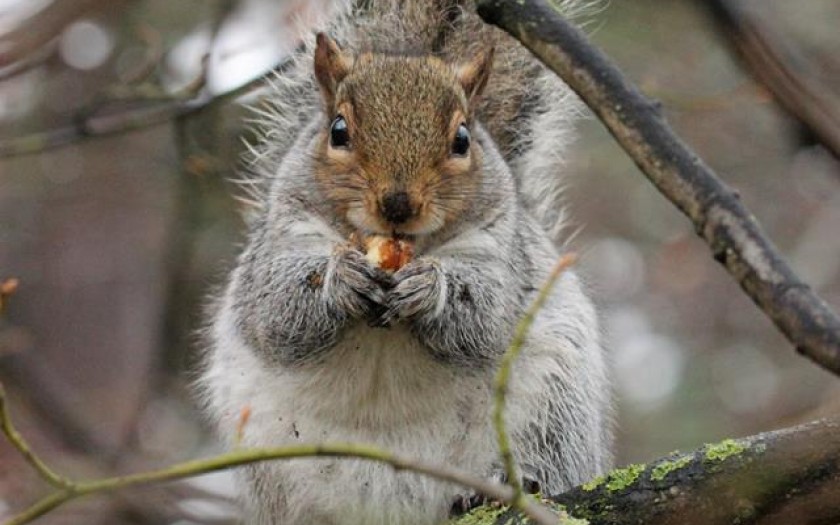International Squirrel Appreciation Day

International Squirrel Appreciation Day
Why are squirrels such an important part of nature?
Many people look at squirrels and see "cute furry creatures", forgetting how important role they play in the ecosystem. It’s worth to present a few well known scientific facts as a reminder:1. Some squirrel species, by burying seeds far from the parent tree, play the role of 'seed dispersers' and natural forest regenerators. Scientific research proved that Eastern grey squirrels are unquestioned leaders in natural forest regeneration, as they not only 'disperse' almost all found seeds, but they also bury only good seeds (not damaged or infested) which have the most chance of germinating [1]. Also Fox squirrels turned out to be great seed dispersers.
2. But it’s not the end of squirrels' 'services' for ecosystems. They also disperse seeds of many species of flowers, fruits and vegetables, and fungi spores. Some species of squirrels, like Eastern grey squirrels and Fox squirrels already mentioned above, control the populations of insects that can cause too much damage in tree plantations. Habitats composed of the trees planted by squirrels and of fungi, vegetables, fruits or flowers dispersed by them, are used by hundreds of other animal species. [2]
3. Squirrels –for example greys, reds, flying squirrels, groundhogs and chipmunks –have their place also in the food chain as they are important food sources for hawks, foxes, coyotes. [3]
Apart from the extremely important role of squirrels for ecosystems, it’s worth remembering that:

4. Squirrels are extremely intelligent and, as scientific research showed, they can use previous experiences to solve problems of the present day, like people do. [4]
5. Squirrels are practical, when you put worse quality food in the squirrel feeder than in the bird feeder, they will use the latter. Although there are already known ways to 'fool them' cheaply. [5]
6. While burying the seeds, some squirrels use a 'special tactic' to protect their caches from others. They pretend to bury a seed in a place, leaving it in fact empty. [6]
7. Squirrels use their intelligence also in fighting predators. Some squirrel species build many nests and move (often with their young) to confuse the predator. [7]

9. For many people around the world, especially in urban areas, squirrels are often the only wild mammals they have a chance to see every day. Millions of people relax watching squirrels play in parks and gardens. [9]
10. Squirrels have many vocal and tail signals that have different meanings depending on how they are used.For example, grey squirrels use the vocalization and the tail flick as alarm signals. [10]
11. 21 January is the International Squirrel Appreciation Day. Let’s celebrate it together with our wonderful forest regenerators. [11]
References:
[1] Goheen, J.R. &Swihart, R.K. (2003) Food-hoarding behavior of gray squirrels and North American red squirrels in the central hardwoods region: implications for forest regeneration. Canadian Journal of Zoology, 81: 1636-1639.
Hanrahan, C. & Belair, A. (2015) FWG Management Committee.
ICSRS (2016b) Grey squirrels (Sciurus carolinensis) food-hoarding behaviour in the UK and the effect on forest regeneration.
Steele, M.A., Hadj-Chikh, L.Z. & Hazeltine, J. (1996) Caching and Feeding Decisions by Sciurus carolinensis: Responses to Weevil-Infested Acorns. Journal of Mammalogy 77: 305-314.
Vander Wall, S.B. (2001) The Evolutionary Ecology of Nut Dispersal. Botanical Review, 67: 74-117.
[2] Chris Maser, Zane Maser: Interactions among squirrels, mycorrhizal fungi, and coniferous forests in Oregon. Great Basin Naturalist, 1988.
Steele, M.A., Hadj-Chikh, L.Z. & Hazeltine, J. (1996) Caching and Feeding Decisions by Sciurus carolinensis: Responses to Weevil-Infested Acorns. Journal of Mammalogy 77: 305-314.
[3] Koprowski JL (1994) Sciurus carolinensis. Mammalian Species 480: 1-9
[4] Chow PKY, Lea SEG, Hempel de Ibarra N & Robert T. (2017) How to stay perfect: the role of memory and behavioural traits in an experienced problem and a similar problem. Animal Cognition, 20: 941–952. doi: 10.1007/s10071-017-1113-7
[5] Advice – how to live in harmony with a squirrel in my garden? ICSRS: Squirrel in my garden, 2015.
[6] Michael A.Steele, Sylvia L.Halkin, Peter D.Smallwood, Thomas J. Matthew Beam: Cache protection strategies of a scatter-hoarding rodent: do tree squirrels engage in behavioural deception? Animal Behaviour Volume 75, Issue 2, February 2008
[7] Steele, M. A., and J. L. Koprowski: North American Tree 2001.
[8] Basic steps to taking care of a baby squirrel. Columbus Squirrel Rescue, Columbus, Georgia, USA.
[9] Caroline Hockenbury. 9 Reasons You Should Actually Love And Appreciate Squirrels. The Little Things.
[10] Thaddeus R. McRae and Steven M. Green: Joint tail and vocal alarm signals of gray squirrels (Sciurus carolinensis) 2014.
[11] Dani Tinker: 10 Nutty Facts to Make You Appreciate Squirrels. The National Wildlife Federation 2015.
Photos: Adrian Spencer, Piera Comorio, SWT
